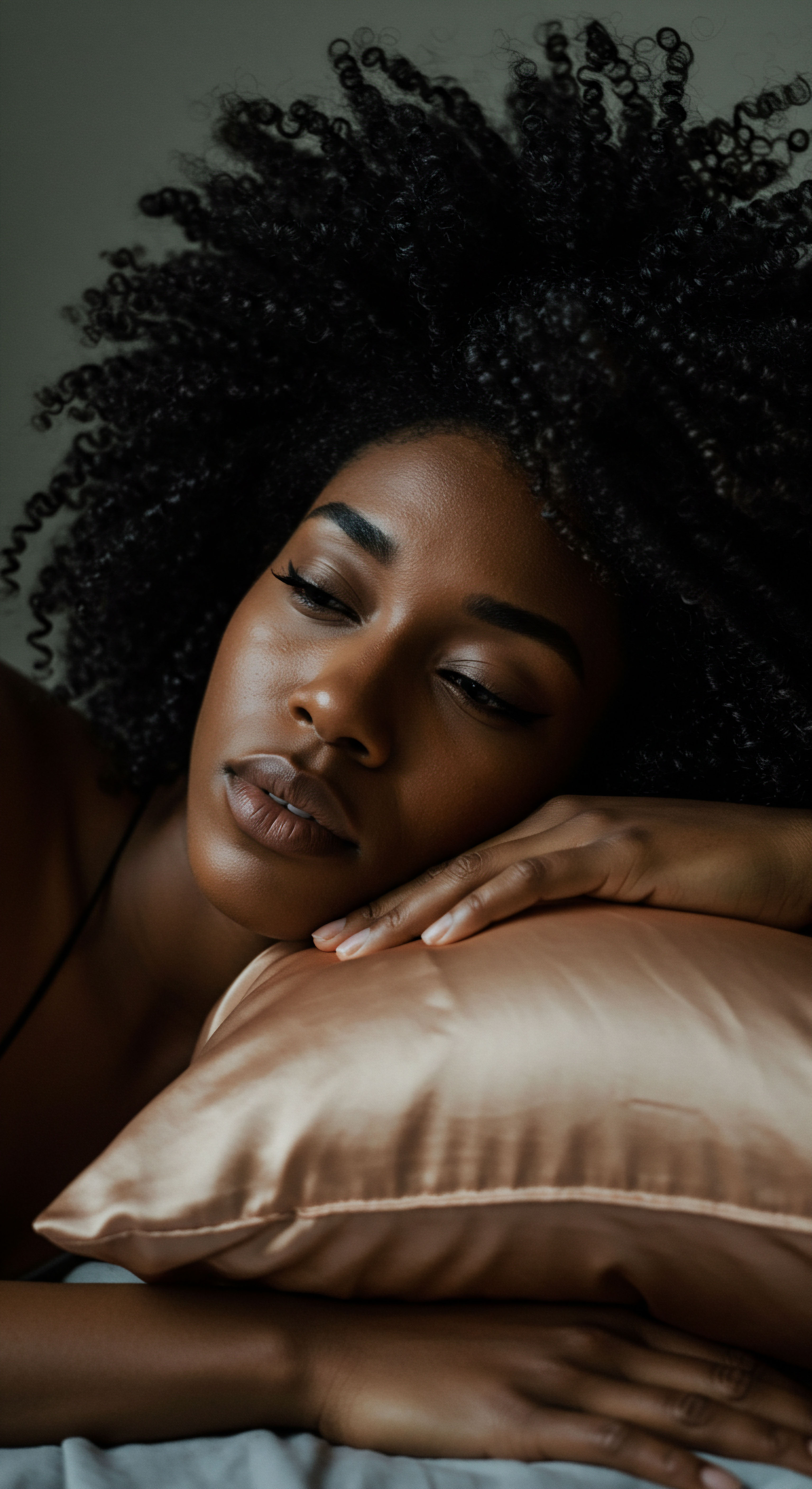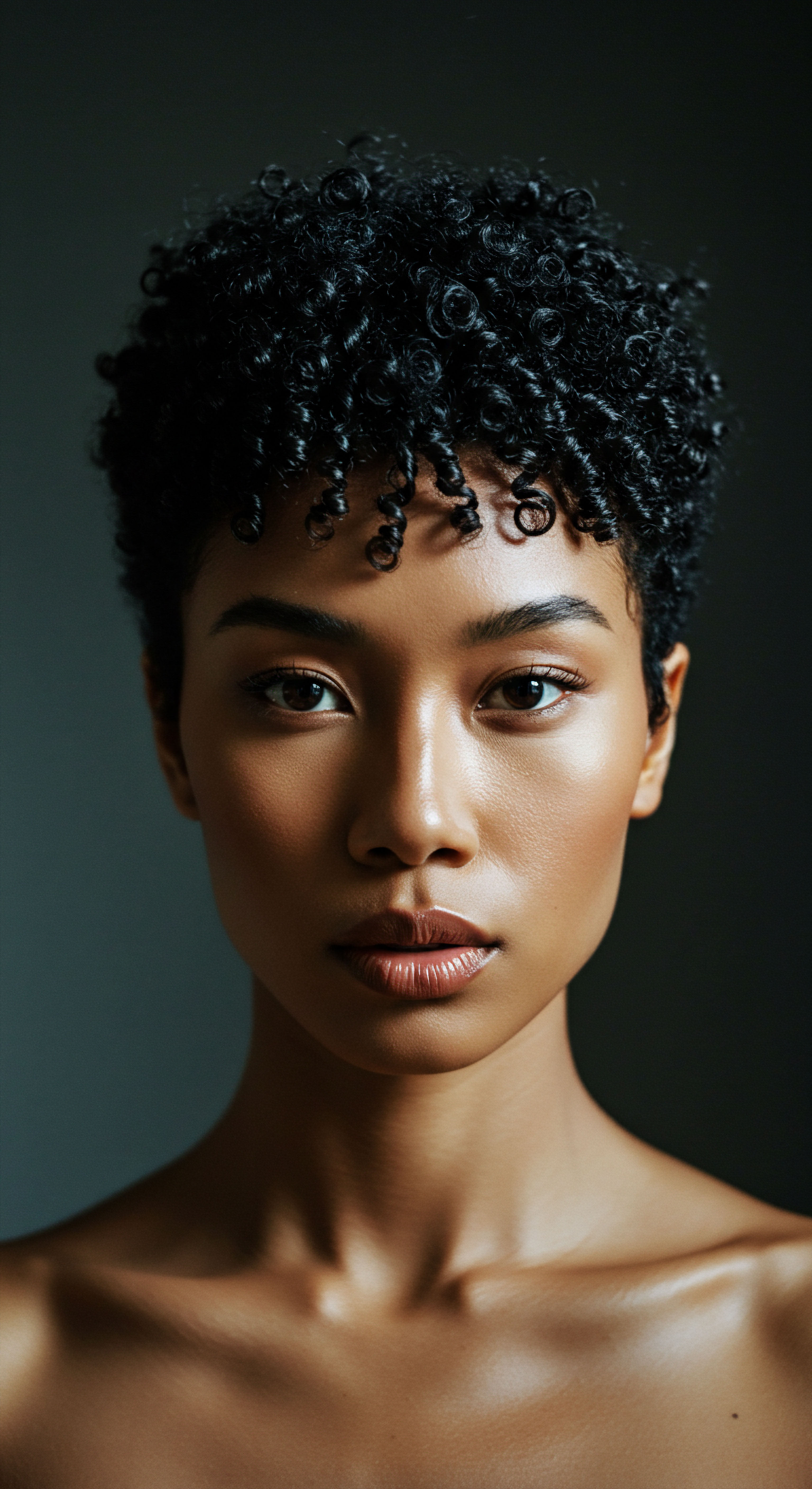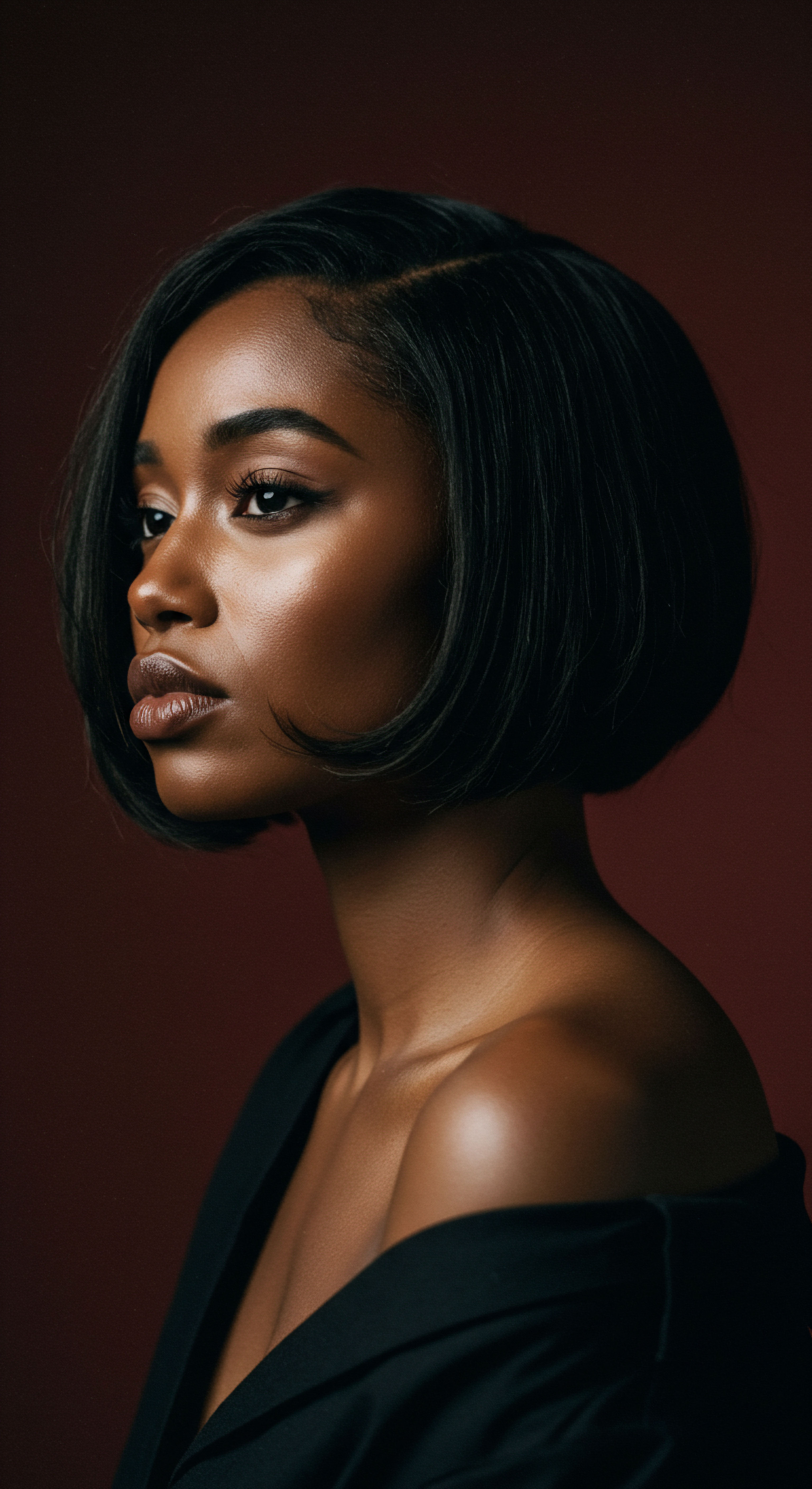
Roots
As dusk descends and the world quiets, a subtle transformation begins within our homes, particularly for those whose crowning glory spirals and coils with a vibrant life of its own. For centuries, the rituals surrounding sleep have held a silent power, often overlooked in the hurried pace of modern living. Yet, for textured hair, these nocturnal hours represent a profound opportunity, a canvas upon which the day’s environmental challenges can either be mitigated or inadvertently amplified. The very notion of rest, for our strands, carries a unique weight, for it is during these deep, unconscious moments that much of their resilience is either fortified or quietly compromised.
The question of how silk fabric influences this nightly repose for curly hair extends far beyond a simple choice of bedding; it delves into the fundamental mechanics of hair health and the preservation of its inherent structure. To truly appreciate the quiet revolution silk brings to our nightly routine, we must first consider the microscopic world of the hair strand itself, particularly as it pertains to the unique architecture of curls.
The nightly interaction between hair and sleep surfaces significantly impacts the long-term health and integrity of textured strands.

Understanding Hair’s Delicate Outer Layer
The outermost shield of each hair strand, the cuticle, resembles a shingled roof, composed of overlapping cells. In straight hair, these shingles lie relatively flat, presenting a smoother surface. However, with curly and coily hair, the cuticle layers tend to be naturally more raised and porous, a characteristic that, while contributing to the hair’s magnificent volume and distinct patterns, also renders it more susceptible to moisture loss and physical abrasion. This inherent openness means that the hair’s internal moisture, so vital for its pliability and vibrancy, can escape more readily, and external forces can more easily disrupt its delicate arrangement.
Consider the sheer surface area of a single curl; its helical form means more points of contact with whatever it rests upon. When this contact is with a coarse, absorbent material, such as traditional cotton pillowcases, the cumulative effect over hours of sleep can be considerable. The microscopic roughness of cotton fibers can catch and lift these already raised cuticle scales, creating friction.
This constant, gentle tugging, repeated night after night, contributes to what many experience as morning frizz, dryness, and even breakage. It is a silent battle waged while we dream, often leaving our curls feeling depleted and looking less defined upon waking.

How Fiber Composition Affects Hair
The intrinsic properties of textile fibers play a paramount role in their interaction with hair. Natural fibers like cotton are hydrophilic, meaning they readily absorb water. While this quality makes them comfortable for clothing, it becomes a disadvantage when it comes to hair.
A cotton pillowcase acts like a thirsty sponge, drawing moisture not only from the air but directly from the hair resting upon it. For curly hair, which often struggles to retain moisture due to its structural characteristics, this constant siphoning effect exacerbates dryness, making the strands more brittle and prone to damage.
In contrast, silk, a protein fiber spun by silkworms, exhibits a distinct molecular structure. Its smooth, long, and naturally lustrous fibers create a surface with significantly less friction. The protein composition of silk also means it is far less absorbent than cotton, allowing hair to retain its natural oils and applied moisture.
This distinction is not merely advanced; it translates directly into tangible benefits for hair health, acting as a gentle counterpoint to the inherent vulnerabilities of textured strands. The delicate balance of moisture and the integrity of the cuticle are quietly upheld throughout the night, setting the stage for more defined, less stressed curls come morning.
- Cuticle Integrity The natural openness of curly hair cuticles makes them more vulnerable to friction and moisture loss, underscoring the importance of a smooth sleep surface.
- Fiber Absorption Cotton’s hydrophilic nature draws moisture from hair, contributing to dryness, whereas silk’s protein structure resists absorption, preserving hair’s natural hydration.
- Surface Friction The microscopic roughness of cotton creates friction, lifting cuticle scales, while silk’s smoothness allows hair to glide, minimizing damage.

Ritual
The transition from day to night, for those with textured hair, often carries with it a quiet contemplation of preparation. It is a time when the practical wisdom gleaned from countless mornings of taming and styling comes into play, informing the protective measures we instinctively adopt before sleep. This nightly ritual, often simple yet profoundly impactful, is where the benefits of silk fabric truly begin to reveal themselves. It moves beyond the foundational science into the realm of lived experience, transforming a mere sleep surface into an active partner in hair preservation.
Consider the deliberate acts we undertake to safeguard our curls ❉ the gentle detangling, the careful application of leave-in conditioners, the meticulous gathering of strands into a pineapple or loose braids. Each step is a conscious effort to protect the hair from the rigors of friction and the relentless pull of gravity during hours of unconscious movement. When these efforts are met with a silk pillowcase or bonnet, the synergy is undeniable, creating a sanctuary for curls that cotton simply cannot offer.
Integrating silk into a nighttime routine provides a crucial layer of protection, preserving the hair’s style and hydration while minimizing friction.

Preserving Moisture and Natural Oils
One of the most persistent challenges for curly hair is maintaining adequate moisture. The natural sebum produced by the scalp, which effortlessly travels down straight strands, often struggles to descend the intricate spirals of curly hair, leaving the ends particularly vulnerable to dryness. Furthermore, products applied to condition and hydrate the hair are often costly and meticulously chosen. A cotton pillowcase, as previously discussed, readily absorbs these precious emollients and the hair’s natural moisture, effectively negating the efforts of a daytime routine.
Silk, conversely, acts as a moisture-retaining ally. Its tightly woven, smooth fibers do not wick away moisture in the same manner. This means that the hydrating serums, leave-in conditioners, and natural oils applied to the hair remain where they belong ❉ on the hair. The difference is often palpable upon waking; curls feel softer, more pliable, and less parched.
This sustained hydration contributes directly to the hair’s elasticity, making it less prone to breakage and more resilient against daily stressors. The subtle sheen often seen in healthy curly hair is a direct reflection of well-hydrated, intact cuticles, a condition silk helps to uphold.

Minimizing Friction and Frizz Formation
The physical interaction between hair and sleep surface is a primary driver of frizz. Frizz arises when the hair’s cuticle layers are raised, allowing moisture from the air to enter the hair shaft and cause it to swell unevenly. Cotton’s abrasive surface constantly rubs against the hair, roughing up the cuticle and creating microscopic damage. This leads to a visibly frayed appearance and a loss of curl definition.
Silk’s smooth texture provides a remarkably low-friction environment. As hair glides across its surface, the cuticle remains undisturbed, lying flat and smooth. This significantly reduces the mechanical stress on the hair shaft, thereby minimizing frizz and preserving the natural curl pattern.
The impact of this reduced friction extends beyond mere aesthetics; it contributes to a tangible reduction in tangles and knots, which are often a precursor to breakage. The effort saved in detangling each morning, and the visible improvement in curl integrity, transforms the daily styling ritual from a struggle into a celebration.
Consider a study published in the Journal of Cosmetic Science which, while not exclusively focused on curly hair, examined the friction properties of various textile surfaces. It found that silk exhibited significantly lower coefficients of friction compared to cotton, suggesting a reduced likelihood of mechanical damage to hair strands during contact. This empirical data underscores the practical benefits observed by those who make the switch to silk, offering a scientific underpinning to the anecdotal experiences of countless individuals with textured hair.
| Characteristic Moisture Absorption |
| Silk Fabric Low, preserves hair hydration |
| Cotton Fabric High, wicks moisture from hair |
| Characteristic Surface Friction |
| Silk Fabric Very low, minimizes cuticle disruption |
| Cotton Fabric High, causes cuticle lifting and frizz |
| Characteristic Hair Protein Compatibility |
| Silk Fabric Protein-based, gentle interaction |
| Cotton Fabric Cellulose-based, more abrasive |
| Characteristic Tangle Reduction |
| Silk Fabric Significant, hair glides freely |
| Cotton Fabric Minimal, can increase tangles |
| Characteristic Silk offers a superior sleep surface for hair, especially textured hair, due to its low friction and moisture-retaining properties. |

Maintaining Curl Definition and Style Longevity
For many with curly hair, maintaining curl definition beyond wash day is a constant aspiration. The nightly tossing and turning, combined with the friction of a traditional pillowcase, can flatten curls, disrupt their carefully crafted patterns, and lead to a general sense of shapelessness by morning. This often necessitates extensive re-wetting and re-styling, adding time and potential product build-up to the morning routine.
Silk provides a smooth, frictionless canvas that respects the integrity of each curl. When hair slides rather than snags, the individual curl clumps remain largely intact. This means that the defined spirals and waves achieved through careful styling are more likely to survive the night.
The result is less need for intensive morning refreshes, leading to healthier hair overall by reducing manipulation and exposure to styling products. The investment in silk becomes an investment in the longevity of one’s style, simplifying the daily dance with textured hair and allowing for more serene mornings.

Relay
Moving beyond the immediate and observable benefits, a deeper inquiry into the influence of silk fabric on curly hair during sleep reveals a complex interplay of material science, biological response, and even cultural resonance. How does this seemingly simple choice of textile ripple through the long-term vitality of textured hair, influencing not only its physical state but also the broader experience of self-care and identity? This section aims to unpack the more profound, interconnected aspects of silk’s contribution, drawing upon a confluence of scientific insight and the quiet wisdom of centuries.
The story of silk and hair is not merely one of friction reduction; it is a narrative woven with threads of biomimicry, cellular protection, and the subtle economics of hair health. To truly grasp its significance, we must consider the cumulative effects of gentle treatment on a hair type that has often faced a history of misunderstanding and harsh handling.
The profound impact of silk on textured hair extends beyond superficial benefits, touching upon the hair’s long-term cellular health and structural resilience.

The Biocompatibility of Silk and Hair Proteins
Both human hair and silk are protein fibers. Hair is primarily composed of keratin, a fibrous protein, while silk is composed of fibroin and sericin. This shared proteinaceous nature contributes to a unique biocompatibility that cellulose-based fibers like cotton cannot replicate.
The amino acid sequences in silk proteins are remarkably similar to those found in human skin and hair. This inherent likeness suggests a more harmonious interaction at a molecular level, reducing the potential for adverse reactions or mechanical stress that might occur with less compatible materials.
When hair, particularly curly hair with its more exposed cuticle, rests upon silk, the interaction is one of gentle recognition rather than abrasive conflict. This molecular kinship translates into a tangible reduction in static electricity, a common nemesis for curly hair. Static electricity arises from the transfer of electrons between surfaces, leading to repulsion between individual hair strands and a chaotic, frizzy appearance.
Silk’s smooth surface and its natural ability to retain a slight amount of moisture, rather than drawing it away, mitigates this electron transfer, leaving curls smoother and more aligned. This is a subtle yet powerful benefit, often overlooked, that speaks to the deeper scientific advantages of silk.

Long-Term Hair Health and Reduced Breakage
The repeated micro-trauma inflicted by rough sleep surfaces contributes significantly to hair breakage over time. While individual instances of a snagged strand might seem minor, the cumulative effect of hundreds of such instances each night, compounded over weeks and months, can lead to visible thinning, shortened strands, and a general lack of vibrancy. For curly hair, which already faces challenges with fragility at its natural bends, this constant abrasion is particularly detrimental.
By drastically reducing friction, silk acts as a preventative measure against this silent attrition. When the cuticle layers remain smooth and intact, the hair shaft is better protected from external damage. This preservation of the cuticle means that the hair’s internal cortex, which provides its strength and elasticity, is less exposed to environmental stressors. Over time, this translates into longer, stronger strands with fewer split ends and less visible breakage.
The investment in silk becomes a strategic move in a long-term hair health regimen, contributing to the overall density and length retention that many with textured hair aspire to. The continuous gentle treatment during sleep provides a restorative environment, allowing the hair to maintain its structural integrity and grow unhindered.
A compelling perspective on the physical properties of hair and its interaction with surfaces can be gleaned from studies in tribology, the science of friction, wear, and lubrication. Research has shown that the coefficient of friction for human hair against various textiles can vary significantly. For instance, a study published in Fibers and Polymers discussed how surface roughness and fiber type influence friction.
While specific curly hair data is still developing, the general principles indicate that smoother, less absorbent surfaces, like silk, inherently reduce the mechanical stress that leads to cuticle damage and subsequent breakage. This understanding grounds the anecdotal benefits of silk in a measurable physical reality, highlighting its role as a protective barrier.
- Protein Compatibility Silk’s protein structure, similar to hair’s keratin, allows for a harmonious interaction, reducing static and cuticle disruption.
- Reduced Micro-Trauma The smooth surface of silk significantly lessens daily micro-abrasions, leading to stronger, longer strands over time.
- Enhanced Length Retention Minimizing breakage during sleep directly supports the ability of curly hair to achieve and maintain desired length.

Cultural Significance of Hair Protection
The practice of protecting hair during sleep is not a modern invention; it holds deep roots within various cultural traditions, particularly within Black communities. Headwraps, bonnets, and other forms of hair coverings have historically served multiple purposes ❉ as expressions of identity, symbols of status, and crucially, as practical tools for hair preservation. The adoption of silk for this purpose, while a relatively recent widespread phenomenon, aligns seamlessly with this long-standing tradition of valuing and safeguarding textured hair.
For generations, mothers and grandmothers have passed down the wisdom of wrapping hair at night, understanding instinctively the need to shield delicate strands from the rigors of sleep. The shift towards silk is an evolution of this ancestral knowledge, leveraging modern understanding of material science to enhance an already vital practice. It is a continuation of a legacy of care, a quiet act of self-preservation that connects individuals to a broader cultural narrative of resilience and beauty.
This historical context imbues the simple act of sleeping on silk with a deeper meaning, transforming it from a mere product choice into a mindful continuation of a cherished tradition. The benefits of silk, therefore, are not just physiological; they are also culturally affirming, providing a modern means to uphold practices that have sustained hair health and cultural pride for centuries.

Reflection
As the morning light gently filters through, revealing the quiet promise of a new day, the subtle impact of our nightly choices becomes evident. The journey through the molecular landscape of hair, the practical wisdom of ritual, and the deeper cultural echoes of protection all converge on a singular understanding ❉ the gentle caress of silk against textured strands during sleep is far more than a luxury. It is a quiet revolution, a consistent act of kindness towards hair that yearns for thoughtful care.
This delicate textile, through its inherent properties, acts as a guardian, preserving the very essence of curls and coils, allowing them to unfurl with a renewed sense of vitality each morning. The embrace of silk transforms sleep from a potential source of stress for our hair into a restorative sanctuary, fostering a lasting vibrancy that truly celebrates the unique beauty of textured hair.

References
- Robbins, C. R. (2012). Chemical and Physical Behavior of Human Hair. Springer Science & Business Media.
- Bhushan, B. (2013). Principles and Applications of Tribology. John Wiley & Sons.
- Kachra, S. & Bajaj, P. (2010). Textile Science and Technology ❉ Hair Fibers. Woodhead Publishing.
- Draelos, Z. D. (2011). Cosmetic Dermatology ❉ Products and Procedures. Wiley-Blackwell.
- Martini, M. C. & Jeanmaire, C. (2012). Cosmetic Science and Technology ❉ Theoretical Principles and Applications. Lavoisier.
- Gavrilov, A. N. (2019). Hair ❉ Its Structure and Properties. Nova Science Publishers.
- Khazaka, M. (2015). Biophysical Measurements of the Skin and Hair. CRC Press.